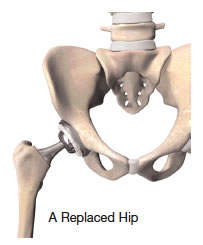Dedicated to Our Patients


 Hip replacement is one of the most important surgical advances of this century. This surgery helps more than 300,000 Americans each year1 to relieve their pain, and get back to enjoying normal, everyday activities. Hip replacement involves the removal of arthritic bone ends and damaged cartilage and replacing them with prosthetic implants that replicate the hip joint.
Hip replacement is one of the most important surgical advances of this century. This surgery helps more than 300,000 Americans each year1 to relieve their pain, and get back to enjoying normal, everyday activities. Hip replacement involves the removal of arthritic bone ends and damaged cartilage and replacing them with prosthetic implants that replicate the hip joint.
Hip replacement surgery may be considered when arthritis limits your everyday activities such as walking and bending, when pain continues while resting, or stiffness in your hip limits your ability to move or lift your leg. Hip replacement may be recommended only after careful diagnosis of your joint problem. It is time to consider surgery if you have little pain relief from anti-inflammatory drugs or other treatments, such as physical therapy, do not relieve hip pain. Hip replacement can help relieve pain and get you back to enjoying normal, everyday activities.
Total hip replacement is often reserved for patients who:
In a total hip replacement operation, the surgeon replaces the worn surfaces of the hip joint with an artificial hip joint. The worn head of the femur (thigh bone) is replaced with a metal or ceramic ball mounted on a stem; the stem is placed firmly into the canal of the thigh bone at its upper end. The acetabulum (hip socket) is prepared and implanted with a metal cup and plastic or ceramic insert. The ball and insert glide together to replicate the hip joint.
References:
1. Orthopedics.about.com website, Feb. 2006.